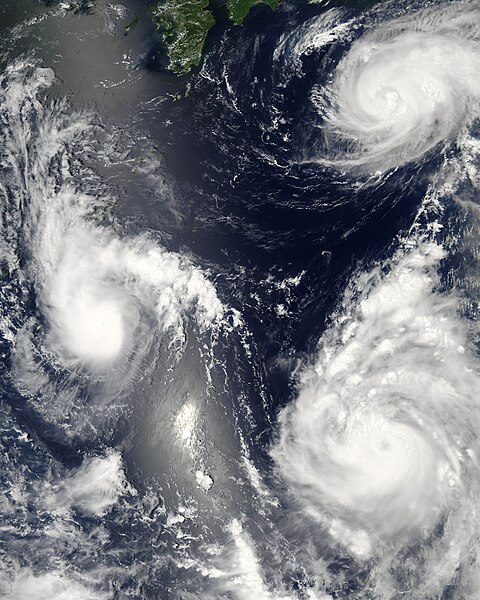Tập tin:Maria, Bopha and Saomai 2006-08-07 0435Z.jpg

Kích thước hình xem trước: 480×600 điểm ảnh. Độ phân giải khác: 192×240 điểm ảnh | 384×480 điểm ảnh | 614×768 điểm ảnh | 819×1.024 điểm ảnh | 1.638×2.048 điểm ảnh | 7.200×9.000 điểm ảnh.
Tập tin gốc (7.200×9.000 điểm ảnh, kích thước tập tin: 7,6 MB, kiểu MIME: image/jpeg)
Lịch sử tập tin
Nhấn vào ngày/giờ để xem nội dung tập tin tại thời điểm đó.
| Ngày/giờ | Hình xem trước | Kích cỡ | Thành viên | Miêu tả | |
|---|---|---|---|---|---|
| hiện tại | 03:06, ngày 8 tháng 8 năm 2006 |  | 7.200×9.000 (7,6 MB) | Good kitty | == Summary == {{Information |Description=Three different typhoons were spinning over the western Pacific Ocean on August 7, 2006, when the Moderate Resolution Imaging Spectroradiometer (MODIS) on NASA’s Aqua satellite acquired this image. The strongest |
Trang sử dụng tập tin
Có 1 trang tại Wikipedia tiếng Việt có liên kết đến tập tin (không hiển thị trang ở các dự án khác):
Sử dụng tập tin toàn cục
Những wiki sau đang sử dụng tập tin này:
- Trang sử dụng tại ar.wikipedia.org
- Trang sử dụng tại az.wikipedia.org
- Trang sử dụng tại bg.wikipedia.org
- Trang sử dụng tại bh.wikipedia.org
- Trang sử dụng tại crh.wikipedia.org
- Trang sử dụng tại cs.wikipedia.org
- Trang sử dụng tại de.wikipedia.org
- Trang sử dụng tại en.wikipedia.org
- Typhoon
- Typhoon Saomai
- Tropical cyclone
- Wikipedia:Picture peer review/Archives/Archive2006
- User:Plasticup/MyFavorites
- Typhoon Maria (2006)
- User talk:Hurricanehink/Archive 23
- User talk:Thegreatdr/2012archive
- Wikipedia:Wikipedia Signpost/2013-11-20/Traffic report
- Wikipedia:Wikipedia Signpost/Single/2013-11-20
- Wikipedia:Top 25 Report/November 10 to 16, 2013
- User:Tfmbty/2006 Pacific typhoon season
- User:SongdaTalas/Archives of Former Articles
- Trang sử dụng tại en.wiktionary.org
- Trang sử dụng tại es.wikipedia.org
- Trang sử dụng tại fi.wikipedia.org
- Trang sử dụng tại hi.wikipedia.org
- Trang sử dụng tại id.wiktionary.org
- Trang sử dụng tại incubator.wikimedia.org
- Trang sử dụng tại ja.wikipedia.org
- Trang sử dụng tại ja.wikibooks.org
- Trang sử dụng tại ko.wikipedia.org
- Trang sử dụng tại lo.wikipedia.org
- Trang sử dụng tại ms.wikipedia.org
- Trang sử dụng tại my.wikipedia.org
- Trang sử dụng tại nn.wikipedia.org
- Trang sử dụng tại no.wikipedia.org
- Trang sử dụng tại pt.wikipedia.org
- Trang sử dụng tại ro.wikipedia.org
- Trang sử dụng tại ru.wikipedia.org
- Trang sử dụng tại szy.wikipedia.org
- Trang sử dụng tại th.wikipedia.org
- Trang sử dụng tại tk.wikipedia.org
Xem thêm các trang toàn cục sử dụng tập tin này.




